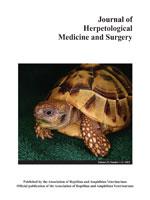Serum chemistry analysis is used for the evaluation of a subject's health status in reptile medicine. Protein electrophoresis, combined with the determination of total protein concentration, is the standard method for the determination of serum albumin concentration. An alternative method is the bromocresol green (BCG) dye-binding method. The BCG method for the measurement of albumin concentration in reptiles may lead to inaccurate results for serum albumin concentration. The aim of this study was to compare the serum albumin values of Hermann's tortoises (Testudo hermanni) obtained by protein electrophoresis and the BCG method and to test the reliability of the BCG method for the measurement of albumin concentration in this species of tortoise. Between May and June 2012, serum samples from 32 Hermann's tortoises, 22 healthy and 10 diseased, were analyzed. Serum albumin concentrations were measured by protein electrophoresis and by the BCG method. The results of the two methods were compared using Passing–Bablok regression and Bland–Altman plots. Albumin concentration measured by BCG was moderately correlated with the corresponding protein electrophoretic values in all tortoises (rs = 0.545, P = 0.001) and in healthy tortoises analyzed separately (rs = 0.491, P = 0.020). In diseased tortoises, correlation between the testing methods was not significant (rs = 0.602, P = 0.066). The albumin concentrations measured using the two methods differed significantly in all tortoises (P = 0.0005; “effect size” = 0.50), in healthy tortoises (P = 0.0262; “effect size” = 0.61), and in diseased tortoises (P = 0.0059, “effect size” = 0.62). In the Bland–Altman plots, a systematic error was found between the two methods in diseased tortoises. The albumin concentrations measured by BCG were significantly higher than those obtained with electrophoresis, especially in diseased Hermann's tortoises. The analysis of albumin in the BCG method gave falsely elevated concentrations. Therefore, for health assessment in Hermann's tortoises, albumin should be measured by protein electrophoresis.
How to translate text using browser tools
1 March 2013
Determination of Serum Albumin Concentration in Healthy and Diseased Hermann's Tortoises (Testudo hermanni): A Comparison Using Electrophoresis and the Bromocresol Green Dye-Binding Method
Roberto Macrelli,
Marcello Ceccarelli M,
Letizia Fiorucci
ACCESS THE FULL ARTICLE
It is not available for individual sale.
This article is only available to subscribers.
It is not available for individual sale.
It is not available for individual sale.
albumin
bromocresol green dye-binding
electrophoresis
Hermann's tortoise
Testudo hermanni





